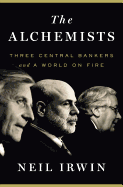Jack Covert Selects - The Alchemists
April 12, 2013
The Alchemists: Three Central Bankers and a World on Fire by Neil Irwin, The Penguin Press, 400 pages, $29. 95, Hardcover, April 2013, ISBN 9781594204623 Central banks are among the world’s most powerful, complicated, and controversial institutions. They are also some of the world’s most secretive and least understood organizations, which makes Neil Irwin’s The Alchemists: Three Central Bankers and a World on Fire such an important addition to our bookshelves.
The Alchemists: Three Central Bankers and a World on Fire
by Neil Irwin, The Penguin Press, 400 pages, $29.95, Hardcover, April 2013, ISBN 9781594204623
Central banks are among the world’s most powerful, complicated, and controversial institutions. They are also some of the world’s most secretive and least understood organizations, which makes Neil Irwin’s The Alchemists: Three Central Bankers and a World on Fire such an important addition to our bookshelves.
The central story of the book follows how the world’s three leading bankers—Ben Bernanke of the U.S. Federal Reserve, Mervyn King of the Bank of England, and Jean-Claude Trichet of the European Central Bank—handled a global crisis of confidence in the foundations of modern capitalism, a system they and their predecessors not only have had great power over, but one they had largely created.
To understand how they had gained such incredible power, Irwin takes us back to the birth of central banking in mid-seventeenth century Sweden, through the ascendency of the City of London at the height of the British Empire, moves through the long, uneven, and contentious development of central banks in the Unites States, and makes clear the role European central bankers had in the lead-up to both of the 20th century’s world wars.
The further you read, the more you begin to understand the title of the book:
The alchemists of medieval times never did figure out a way to create gold from tin, but as it turned out, it didn’t matter. A central bank, imbued with power from the state and a printing press, had the same power. With that power, it creates the very underpinnings of modernity. As surely as electric utilities and sewer systems make modern cities possible, the flow of money enabled by central banks makes a modern economy possible.
It all started rather poorly when a charismatic man with a checkered past changed his name to Johan Palmstruch, moved to Sweden and gained the confidence of its most powerful men to became the world’s first central banker. He was a financial innovator that would provide the liquidity the Swedish trading empire needed by issuing paper bank notes in lieu of their standard “coins,” which were cumbersome, copper daler (note its similarity to the word dollar) plates that weighed more than forty pounds. Those paper notes would eventually lose their value as they were overprinted, lost any relationship to the daler plates that were supposed to be held in the bank to back them—which had themselves been lent out—and people lost confidence in the man and institution behind him, causing a run on the bank. But the liquidity Palmstruch provided was a powerful lubricant, and though his bank failed, the idea stuck. The central bank set up in 1668 in the aftermath of Palstruch’s debacle would eventually become the Sveriges Riksbank, which remains Sweden’s central bank today.
The world has changed drastically since then, but central bankers’ main job is still to create and destroy money—or manage financial liquidity—and maintain confidence in the system.
The actual work of creating or destroying money in modern times is as banal as it is powerful: a handful of midlevel workers sit at a computer on the ninth floor of the New York Fed building in lower Manhattan, or on Threadneedle Street in the City of London, or at the German Bundesbank in Frankfurt, and buy or sell securities with the stroke of their keyboards. They are carrying out orders of policy-setting committees led by their central bankers. When they buy bonds, it is with money that previously did not exist; when they sell, those dollars or pounds or euros cease to exist.
The history of the central banks has been checkered at best. Rather than revealing a model of behavior, it is an ever-evolving lesson in management. The three bankers at the heart of this book learned a great deal from past failures and have so far managed to largely weather the storm and prevent another great depression. Irwin’s book is an exciting history of those events and an excellent analysis that shows what future bankers and business people can learn from their failures and the pursuit of such alchemy.



